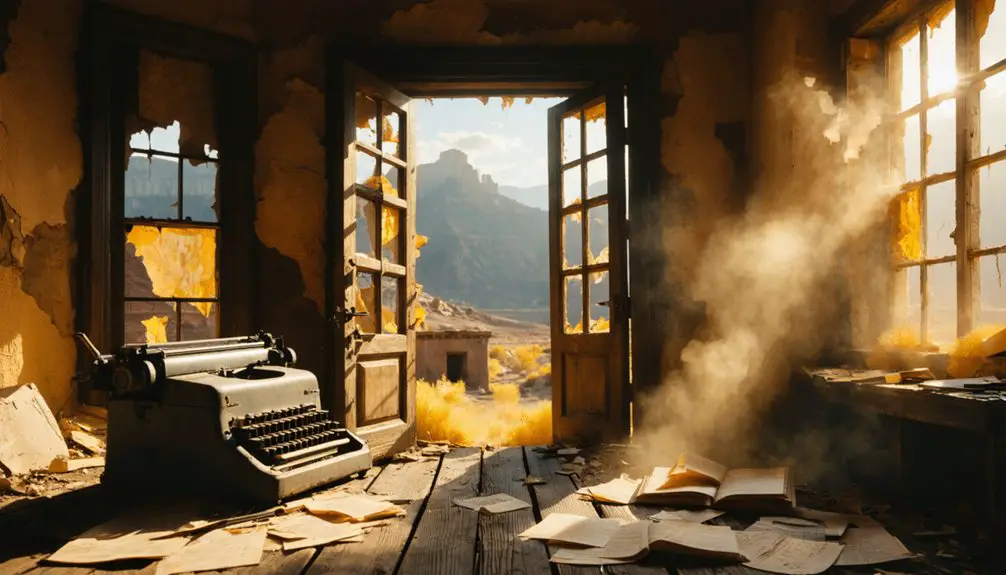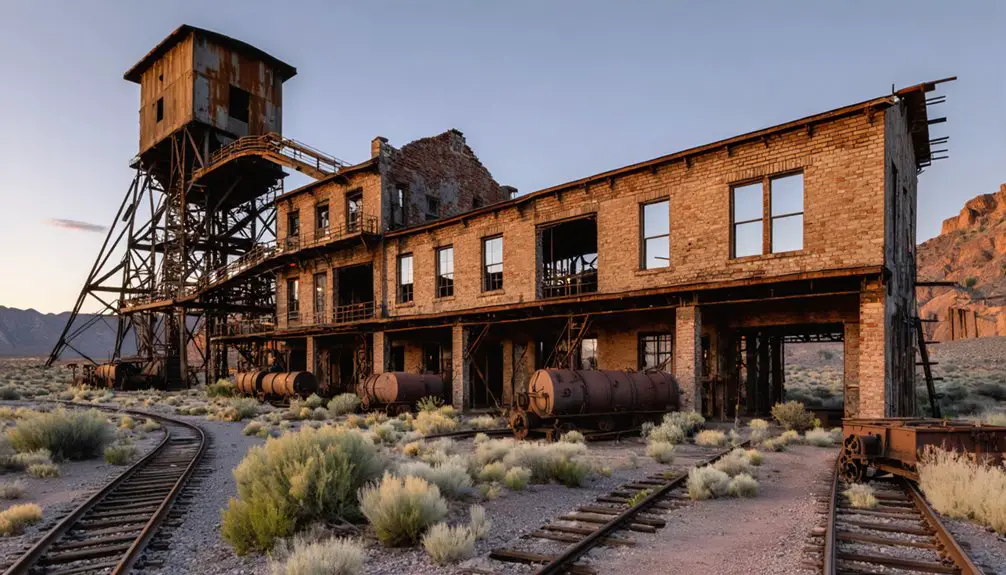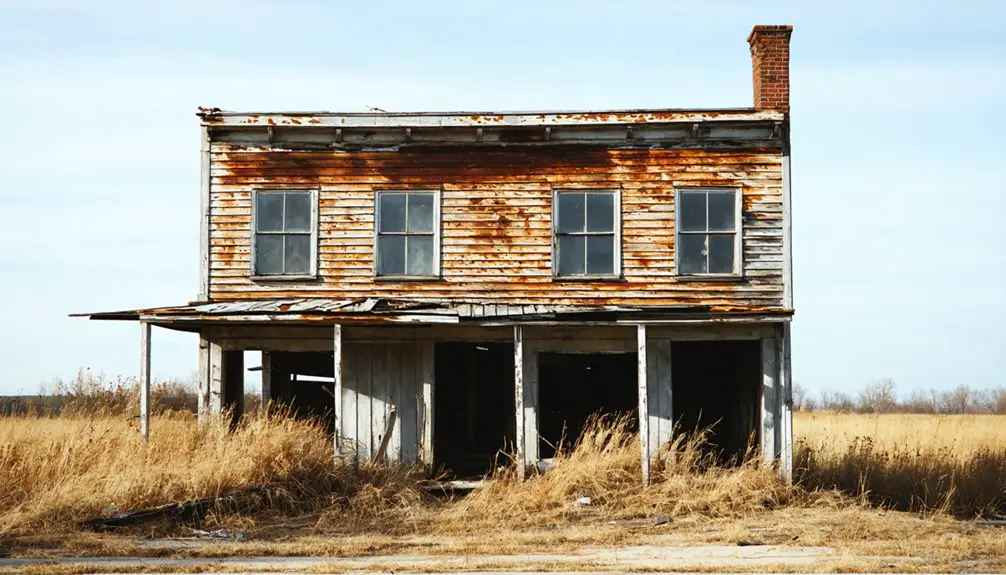You won’t find Jerome in Florida – this notorious copper mining town sits perched on Arizona’s Cleopatra Hill. From 1876 to 1953, Jerome produced nearly $1 billion in copper, earning the title “Wickedest Town in the West” for its lawless atmosphere of saloons and brothels. After surviving massive sinkholes, underground fires, and the devastating 1918 Spanish Flu, this once-abandoned city has transformed into a thriving artistic community with a fascinating tale of boom, bust, and rebirth.
Key Takeaways
- The provided background information appears to be about Jerome, Arizona, not Jerome, Florida, as specified in the search query.
- Jerome, Florida was a small logging town established in the late 1800s in Taylor County, Florida.
- The town declined after local timber resources were depleted and the sawmill closed in the early 1900s.
- Few visible remains of Jerome, Florida exist today, with most structures having deteriorated or been reclaimed by nature.
- The site of Jerome, Florida is located near modern-day Perry, but is largely inaccessible to the public.
The Copper Mining Boom That Started It All
While prospectors first discovered copper deposits on the steep slopes near present-day Jerome in 1876, the area’s true mining potential emerged in 1883 when initial claims were sold to the United Verde Copper Company.
The initial copper discoveries proved incredibly promising, with a small blast furnace producing nearly $1 million in copper by 1884. The company successfully processed 5,000 tons of ore in just the first four months of operation. However, you’ll find that early mining techniques weren’t sufficient to overcome the operational challenges of the region. The town was named after Eugene Jerome, the company’s principal investor.
The real transformation began when William A. Clark purchased majority stock in 1888, revolutionizing operations with a narrow-gauge railroad that dramatically cut freight costs.
Under Clark’s leadership, the United Verde Mine became Arizona Territory’s largest copper producer by 1900, transforming a modest camp of canvas shacks into a thriving mining town of over 2,500 residents.
A Town Built on Unstable Ground
The town of Jerome faced an existential challenge from its very foundation, perched precariously on the steep slopes of Cleopatra Hill above Verde Valley.
Perched high on Cleopatra Hill’s treacherous slopes, Jerome clings to existence, defying gravity above Arizona’s Verde Valley.
You’ll find that nature and human activity created a perfect storm of geological hazards: Precambrian volcanic rocks with ancient fault lines formed an unstable foundation, while extensive copper mining operations further compromised slope stability.
The mining companies’ use of massive explosives – up to 200,000 pounds per blast – severed rock masses and destroyed natural support systems. The United Verde Open Pit became a visible testament to the massive scale of mining operations that transformed the landscape.
Smelter fumes killed off vegetation, eliminating essential root networks that once held the soil together. As a result, you can still see how buildings cracked, roads shifted, and sinkholes emerged. The town’s reputation as a copper mother lode brought both prosperity and destruction to the area.
Despite modern monitoring systems and drainage improvements, Jerome’s battle with unstable ground continues to shape its destiny.
Tales From the “Wickedest Town in the West”
You’d have found Jerome’s notoriety as the “Wickedest Town in the West” well-earned during its mining heyday, when the largely male population of 15,000 sought entertainment in numerous gambling houses, saloons, and brothels.
The local newspaper, The Sun, officially bestowed this infamous title upon Jerome in 1903, acknowledging the town’s reputation for vice, drunkenness, and raucous behavior.
The dangerous nature of copper mining drove exhausted workers to seek relief through gambling, drinking, and other illicit activities, creating a wild atmosphere that would define Jerome’s character for decades to come.
Poor sanitation and disease outbreaks led to high mortality rates, especially among the town’s children, further contributing to Jerome’s infamous reputation.
Jerome’s history as a bustling mining camp began in 1883 when the United Verde Copper Co. established operations on Cleopatra Hill.
Wild West Mayhem Reigns
During Jerome’s peak mining years from 1883 to 1929, this Arizona copper town earned its notorious reputation as the “Wickedest Town in the West” through a potent combination of lawlessness, vice, and unchecked growth.
You’ll find that outlaw legends thrived in this rugged settlement perched on Cleopatra Hill, where nearly 80% of residents were hard-drinking miners seeking entertainment in the town’s numerous saloons and brothels. The wild atmosphere, now said to fuel ghostly hauntings, stemmed from Jerome’s rapid expansion that overwhelmed early law enforcement efforts. The Industrial Workers World organizers sparked major labor strikes in 1917, adding to the town’s tumultuous character. The area became the largest copper producer in the Arizona Territory by the early 1900s, attracting thousands of fortune seekers.
- Copper mines operated 24/7, generating up to $2,000 daily and fueling a booming vice economy
- Limited infrastructure and wooden buildings contributed to disorder until the 1899 brick building code
- Constant influx of single male miners created an explosive mix of violence, gambling, and revelry
Brothels and Bar Brawls
Jerome’s explosive mix of vice and revelry centered around its eight full-time brothels and more than twenty saloons, which formed the beating heart of this notorious mining town.
You’d find the red light district along “Prostitution Row,” where madam “Belgian Jennie” Bauters ran the infamous “Jennie’s Place” from 1898. The prostitution history and saloon culture thrived due to a population that was 78% male around 1900.
Life was dangerous and wild – gunfights erupted frequently, and bar brawls spilled into the streets. The lawless atmosphere continued until Jerome became the fourth largest city in the Arizona Territory, housing 15,000 residents at its peak.
Between 1894 and 1898, major fires ravaged the town, some linked to its illicit activities. The mix of brothels, gambling, and opium dens earned Jerome its reputation as the “wickedest town in the West,” a label that drew fortune seekers and fueled its volatile atmosphere. The town’s copper mines produced an astounding three million pounds of copper monthly, attracting countless prospectors to its dangerous slopes.
Mining Disasters and Natural Calamities
You’ll find Jerome’s history marked by devastating underground mine fires that threatened both workers and the town’s structural integrity above.
As the mines expanded beneath the settlement, sinkholes began swallowing buildings whole, forcing residents to abandon or relocate entire blocks of the town.
The Spanish Flu epidemic of 1918 dealt another brutal blow to Jerome’s population, overwhelming local medical facilities and claiming numerous lives in the already hazard-prone mining community.
Underground Fires Ravage Mines
When sulfide minerals encountered air in Jerome’s United Verde mine in 1894, they sparked devastating underground fires that would burn relentlessly for over two decades. The infernos ravaged tunnels and mining areas, reaching temperatures above 150 degrees Fahrenheit, while porous rocks and earth cracks allowed oxygen to fuel the flames.
Despite attempts to flood the mines with water and carbon dioxide, you couldn’t extinguish these persistent fires.
- Mining safety deteriorated as hot gases and steam triggered deadly explosions
- Only specialized Spanish miners could endure the extreme underground heat
- Dozens of miners died or suffered severe injuries from fire-related accidents
The uncontrollable blazes eventually forced a complete alteration to open-pit mining by 1920, marking the end of Jerome’s underground mining era.
This shift prolonged copper extraction but forever changed the town’s mining landscape.
Sinkholes Swallow Town Buildings
Three major factors conspired to create Jerome’s devastating sinkhole crisis: extensive underground mining that carved out 88 miles of tunnels, naturally unstable geology, and the region’s location within Florida’s notorious “sinkhole alley.”
The vast network of mineshafts gradually weakened ground stability beneath the town, creating voids that developed into massive sinkholes capable of swallowing entire city blocks.
You’ll find that sinkhole formation accelerated structural instability throughout Jerome, forcing residents to repeatedly rebuild their homes and businesses.
After 1899, construction shifted from wood to brick and stone to better withstand the ground’s collapse. Despite these efforts, the unstable ground continued swallowing buildings until mining operations ceased underground in 1918.
Even after the mines closed permanently in 1953, the subsurface legacy left Jerome vulnerable to ongoing sinkhole hazards.
Deadly Spanish Flu Impact
During the devastating Spanish Flu pandemic of 1918, Jerome’s thriving mining community lost more than one-third of its population, marking a tragic turning point in the town’s history.
Public health officials struggled to contain the rapid spread as the disease overwhelmed hospitals and morgues, leading to mass burials and a desperate shortage of coffins. The multicultural mining town, home to workers from over 30 nationalities, faced unprecedented restrictions and quarantines.
- Officials limited funerals to 15 minutes and distributed gauze masks to curb transmission
- Widespread misinformation led some to believe the flu emerged from the ground itself
- The pandemic struck down healthy young adults and miners, defying typical flu patterns
The Spanish Flu’s devastating toll, combined with mining disasters and environmental damage, contributed greatly to Jerome’s eventual decline and abandonment.
The Cultural Melting Pot of Early Jerome
Although Jerome’s early history emerged from a complex tapestry of cultural influences, its foundation as a settlement exemplified Florida’s remarkable diversity in the 18th and 19th centuries.
You’ll find that Indigenous Heritage played a vital role, with Timucua and Creek Indians establishing early patterns of land use and resource management.
Early Settlements in the region reflected a blend of Spanish, French, and English Colonial influences, while Cultural Influences from African-descended populations enriched the community’s fabric after the Civil War.
Demographic Changes accelerated as European settlers established plantations, introducing new agricultural practices like cotton and sugar cane cultivation.
The area’s development was shaped by this dynamic interplay of Native American knowledge, European colonial ambitions, and African American contributions to the local economy.
From Bustling City to Abandoned Streets

Once a thriving copper mining hub with 15,000 residents in 1929, Jerome’s decline began dramatically in the 1930s when the Great Depression sent copper prices plummeting.
By 1953, major mining operations ceased entirely, transforming this bustling mountainside city into a near-empty shell of its former glory. You’ll find ghostly remnants of Jerome’s heyday in its abandoned architecture, with many buildings either crumbling or stripped for materials.
- Environmental disasters accelerated the town’s demise, as smelter fumes killed vegetation and destabilized the terrain.
- The population plummeted to fewer than 50 people by the late 1950s.
- Massive open-pit blasting left the land vulnerable to landslides, further threatening the remaining infrastructure.
The town’s dramatic fall from prosperity to near-abandonment stands as a stark reminder of mining boom-and-bust cycles.
The Artists’ Renaissance and Modern Revival
In the wake of Jerome’s near-abandonment, a remarkable artistic renaissance transformed the former mining town beginning in the 1960s.
You’ll find that artists, musicians, and craftspeople discovered Jerome’s potential, renovating abandoned buildings and establishing a thriving artist community. They secured national historic district status, protecting the town’s unique character while attracting more creative individuals.
The transformation sparked a cultural tourism boom that continues today. You can explore over 20 artist studios and galleries, participate in monthly Art Walks, and experience the annual Plein Air Festival.
The Verde Valley Art Association and Jerome Historical Society support this creative ecosystem, which has grown the population to 444 by 2010.
Jerome’s evolution from ghost town to artistic haven demonstrates how creative vision can breathe new life into forgotten places.
Preserving Jerome’s Mining Legacy Today

While Jerome’s mining operations ceased decades ago, the town’s dedication to preserving its industrial heritage remains steadfast through meticulous conservation efforts.
You’ll find historical preservation at work in the carefully maintained 1918 Audrey Shaft Headframe and the Jerome Grand Hotel, formerly the United Verde Hospital.
Community engagement thrives through educational programs and walking tours that showcase the town’s 88 miles of underground tunnels and mining artifacts.
Jerome’s rich mining legacy lives on through community-led tours exploring vast tunnel networks and preserved industrial relics.
- Experience hands-on history at museums displaying artifacts from immigrant miners and technological advances in copper extraction
- Explore secured mine shafts with glass covers that allow you to peer into Jerome’s underground past
- Join local historians and mining families who keep oral traditions alive through storytelling events and guided heritage tours
Frequently Asked Questions
Are There Any Documented Paranormal Activities or Haunted Locations in Jerome?
You’ll discover rich ghost stories at Jerome Grand Hotel, Clinkscale Hotel, and Ghost City Inn, where documented haunted history includes apparitions, moving objects, phantom sounds, and spirit encounters reported by guests.
What Is the Average Temperature and Climate Throughout the Year?
You’ll experience mild winters around 53°F and warm summers peaking at 92°F, with low average rainfall throughout the year. Seasonal variations are moderated by the 5,000-foot elevation.
How Far Is Jerome From Phoenix and Other Major Arizona Cities?
You’ll find Jerome 100 miles north of Phoenix, typically a 2-hour drive. It’s 45 miles from Flagstaff, 28 miles from Prescott, and accessible via Route 89A through scenic mountain roads.
What Are the Current Real Estate Prices and Availability in Jerome?
You’ll find plummeting real estate trends in Jerome, with property types selling well below asking price. Inventory has surged 47%, homes stay listed 70+ days, and prices have dropped 5-10% year-over-year.
Does Jerome Have Any Annual Festivals or Special Community Events?
You’ll find the Jerome Indie Film & Music Festival as the main annual celebration. While other community gatherings aren’t widely documented, the festival’s unique ghost town setting draws artists and culture enthusiasts.
References
- https://our38ftlife.com/2017/01/22/exploring-the-ghost-town-of-jerome/
- https://2dadswithbaggage.com/jerome-spooky-ghost-town-haunted-too/
- https://fernwehtun.com/2023/03/19/wicked-city-jerome-americas-largest-ghost-town-is-full-of-surprises/
- https://thesuitelifeoftravel.com/a-copper-mining-ghost-town-jerome-state-historic-park/
- https://azstateparks.com/jerome/about-the-mansion/period-history
- https://thelittledaisyjerome.com/history/
- https://jerome.az.gov/jerome-then-and-now
- https://westernmininghistory.com/towns/arizona/jerome/
- https://en.wikipedia.org/wiki/Jerome
- https://azgs.arizona.edu/photo/unstable-ground-jerome-arizona



